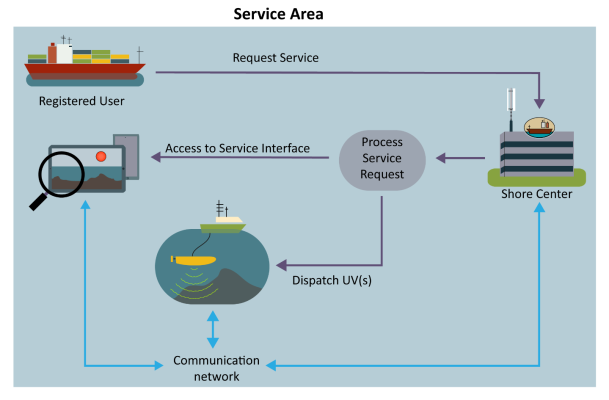Robotic Vessels as a Service – The deployment of robot-based maritime nearshore services
19.03.2021
Whether in port or in coastal areas – the inspection of infrastructure and ships is essential to ensure functionality and safety. It is still commonplace for many professional divers to carry out this task, navigating occasionally in murky waters. The dangers of such inspections should not be neglected.
The international research project RoboVaaS has set itself the task of making the inspection of ships and port infrastructures not only safer but also more efficient through the use of drones.
Benjamin Blanck, responsible for the R&D project at the Hamburg Port Authority, told us in an interview how exactly the technology works, which international partners are involved and what role the Port of Hamburg plays.
 Benjamin Blanck, responsible for the coordination of the R&D project RoboVaaS
Benjamin Blanck, responsible for the coordination of the R&D project RoboVaaS

homePORT: Dear Benjamin, first tell us something about yourself and your role at the Hamburg Port Authority.
Hello, my name is Benjamin Blanck and I am responsible for the RoboVaaS research and development project within the HPA since 2018. I did my Bachelor’s degree in Business Informatics at the University of Hamburg and was born and raised here. At the moment, I’m doing a part-time Master’s degree in ITMC, also at the University of Hamburg.
homePORT: Benjamin, can you start by briefly explaining what the abbreviation RoboVaaS stands for?
RoboVaaS stands for “Robotic Vessels as a Service”. The idea behind our research and development project is that we offer robot-assisted use cases as a service, for example for inspections in ports or other maritime, coastal contexts. You can compare this to a cloud server that you can rent and then don’t have to set up, configure or maintain yourself.
The vision for the future is that you can order an inspection of a ship’s hull from an underwater drone via a web interface and it will then be carried out. You then get your results through the same interface without having to have any know-how or even the hardware.
homePORT: Who are the project partners and what is the role of the HPA?
B: We are a total of seven partners from three countries. Germany, Ireland and Italy.
From Germany we have the Fraunhofer Center for Maritime Logistics and Services as the project coordinator of our research consortium, the SmartPORT Institute of the TU Hamburg and Kraken Robotik as an SME, as well as the HPA.
Our partners in Ireland are the University of Limerick with the Center for Robotics and Intelligent Systems (CRIS) and SonarSim Ltd. And in Italy, the University of Padua with the SIGNET laboratory is working with us on the project.
The role of the HPA is to represent the user perspective for such services in the consortium. As the HPA, we manage the port and provide the infrastructure. We see drones in the port as a kind of digital infrastructure that is being enabled by the as-a-service approach. In the project, we also provide test areas in the port to build up our concept under real world conditions.
homePORT: What is your task in the project?
B: My task in the project is to pass on the user perspective of our specialist departments to our research partners in the consortium, so that targeted development can take place. For example, the HPA is already using the latest technology with the Echo1 drone to carry out ground surveys in the port. It’s important to get their expert opinions when it comes to developing an as-a-service concept in the future, if we want to base it in reality and provide a reliable concept and service. Of course, I also take care of the ongoing project business and all reporting for the HPA tasks. Towards the ITS World Congress, I am planning the demonstration event in close cooperation with the CML as project coordinator, which will be the conclusion of our project.
homePORT: What was the reason for initiating the project?
B: The idea was to create a concept that would make coastal maritime operations safer and more efficient, taking into account forward-looking digital trends such as the as-a-service idea, in order to create a solution that would be scalable in the future and also transferable to other contexts (such as the maintenance of aquacultures).
One motivation for increasing safety, for example, is that many underwater inspection tasks are carried out by divers. While this work is carried out under strict safety precautions, a residual risk remains. If an unmanned underwater vehicle is damaged, it is replaceable. A human life is priceless.
homePORT: Are you pioneers in this context or are there other research teams working on the topic?
B: At the time of application, our research consortium was not aware of any other project working on such a concept. Of course, our research partners in the consortium exchange information with other projects at conferences and in meetings. There are also other projects within the HPA that form synergies with RoboVaaS and with which we are in close exchange. As an example, I can mention SeaClear, which the HPA is also involved in as a partner in the associated research consortium.
homePORT: How soon can the project be (fully) realised?
B: At the end of the project, we will have a complete concept and a usable demonstrator, which corresponds to a TRL (Technology readiness level) of 5 to 6. It may then take another 5 to 10 years before the concept is further developed into a fully established service. It depends heavily on legislation and the miniaturisation of previously available sensors. There must be clear guidelines regulating e.g. autonomous driving of ASVs in port that do not affect the safety and ease of shipping traffic.
homePORT: What problems and obstacles are you currently facing?
B: One challenge for us is the turbidity of the water in the port of Hamburg. One of our use cases is the inspection of quay walls in the port area. In technical exchange meetings that we have held in this context with divers in the port, the turbidity was repeatedly cited as a problem. In some cases, visibility is severely limited, so that divers have to rely on their sense of touch during inspections.
homePORT: How do you plan to use the possibilities that homePORT offers for the project?
B: homePORT provides us with the opportunity to conduct further tests on autonomous waypoint navigation on a water test area in the port of Hamburg. We will also present our project as an ITS anchor project at the ITS Congress 2021 in Hamburg on the homePORT site. We will present the complete RoboVaaS pipeline with live and video demonstrations covering all RoboVaaS scenarios. As part of the homePORT community, we are of course also looking forward to the opportunity to exchange ideas with other research and development teams.
homePORT: Thank you very much for your time, Benjamin. It’s a really exciting project that we wish you all continuing success with.
